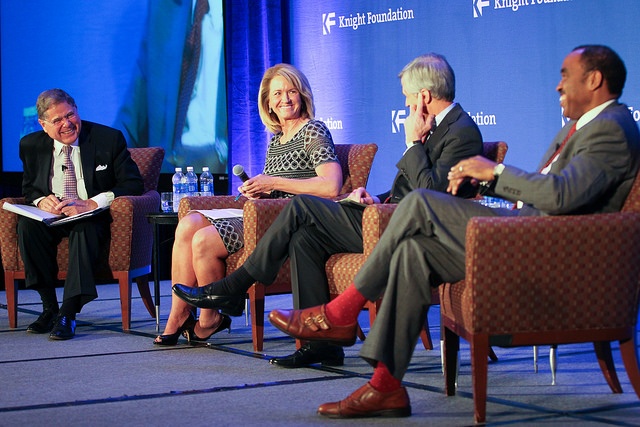
How to apply human-centered design at home: Lessons from the Media Learning Seminar
Photo credit: Knight Foundation on Flickr.
An approach to problem solving called “human-centered design” starts with a simple premise: How can we help people live better? Whether it’s creating a new gadget or device, or coming up with solutions for social issues in a city, a design-thinking framework blends actual human behavior with what’s technologically feasible to yield creative, and hopefully effective, results. RELATED LINKS
“4 new community information investments focus on high-impact projects” by Marika Lynch on KnightBlog.org
“How to open up the data in your community to help solve problems” by Elise Hu on KnightBlog.org
“Embracing change: Five key lessons from innovative community foundations” by Elise Hu on KnightBlog.org
“Journalism as knowledge: covering solutions to strengthen communities” by Michael D. Bolden on KnightBlog.org
“How to apply human-centered design at home: Lessons from the Media Learning Seminar” by Elise Hu on KnightBlog.org
“Strengthening communities: The case for talent, opportunity and place” by Elise Hu on KnightBlog.org
“Going for Goal: Shared knowledge inspires successful Giving Days” by Bahia Ramos on KnightBlog.org
“Using design thinking for community information needs” by Marika Lynch on KnightBlog.org
“2014 tech trends that will impact foundations” by Elise Hu on KnightBlog.org
“Join us – virtually – for a conversatino on community news and information” by Marika Lynch on KnightBlog.org
It’s this human-centered framework that’s embedded deeply into this year’s Media Learning Seminar. The designers at DS4I ran a two-day “Knight Information Culture Lab” for participants, a hands-on, interactive experience that taught the human-centered design process through actual case studies and physical prototyping.
The lab began by helping participants understand that civic culture can’t be nurtured without understanding a place’s information culture first. What are the information needs, biases, sources, styles and issues? One community may not have any “mass” media like newspapers, but it could have a really robust community center at the local Walmart, where residents learn and share information. Another community may not use the English language for information transfer at all. Understanding each place’s unique information ecosystem is a critical starting point for engaging citizens.
Using specific case studies and the stuff of elementary school — popsicle sticks, colored paper and pipe cleaners – the lab encouraged teams of participants to actually model the design process they can put to place in their own communities: Discovery (information gathering about the context of a place), Ideation (brainstorming based on insights), Specification (making the ideas tangible with prototypes) and Iteration (changing things up based on feedback).
Lessons Learned
By the end of the workshop, the takeaways were clear and there were lots of them. Participants learned how to “design to relate rather than design to inform.” This approach shows a willingness to change an approach based on how a community actually transfers knowledge.
Inviting the community into a conversation will show you the problem differently than you see it. “The solution belongs to the community, and when they get to talking, they’ll get to solutions for the problems on the table,” one participant said, of how the “Knight Information Culture Lab” reframed her thinking.
In the excitement of trying to advance our fields, it’s sometimes easy to forget that our solutions and programs have to connect with people who understand the world in a different way. When faced with a case study about a Spanish-speaking community, it made clear to non-Spanish speaking participants how important it is to have the people affected most by a problem at the table.
And don’t forget how much fun this work can be. Approaching problem solving in a collaborative, non-linear and iterative way is just more fun. Groups got to work together, play, talk things out, be creative and concentrate on their goals instead of all the obstacles that could get in the way.
The result of this audience-focused approach will hopefully give people what they want to live better, instead of just what one group thinks it needs.
Check out the blog at DS4SI to learn about its work, and read about how human-centered design also influences Knight’s Prototype Fund in Journalism and Media Innovation with a post from Knight’s Chris Barr.
Elise Hu is a journalist at NPR and a consultant for Knight Foundation.
Recent Content
-
Community Impactarticle ·
-
Community Impactarticle ·
-
Community Impactarticle ·


